When exploring gardens with rich cultural history, I find the Japanese Zen Garden speaks to simplicity, while the Formal French Garden embodies order and elegance. The English Cottage Garden celebrates biodiversity, and the Persian Garden symbolizes paradise. Furthermore, the Italian Renaissance Garden reflects harmony and viewpoint, alongside distinctive cultural scenery patterns. Each layout not only showcases beauty but also tells a story. If you're curious about the elements that contribute to these enchanting designs, there's much more to uncover.
Quick Takeaways
- Japanese Zen Gardens emphasize impermanence and meditation through minimalist designs, reflecting Zen Buddhism's principles of tranquility and contemplation.
- Persian Gardens symbolize paradise with their Chahar Bagh layout, highlighting geometric patterns and flowing water features for spiritual renewal.
- Formal French Gardens showcase meticulous order with symmetrical paths and geometric flower beds, representing elegance and structured beauty in garden design.
- Italian Renaissance Gardens blend natural beauty with architectural elements, emphasizing balance, proportion, and symmetry through their intricate designs and water features.
- English Cottage Gardens celebrate biodiversity and vibrant plant displays, attracting pollinators while reflecting the cultural appreciation for nature's abundance in gardening.
The Japanese Zen Garden: A Reflection of Simplicity and Nature
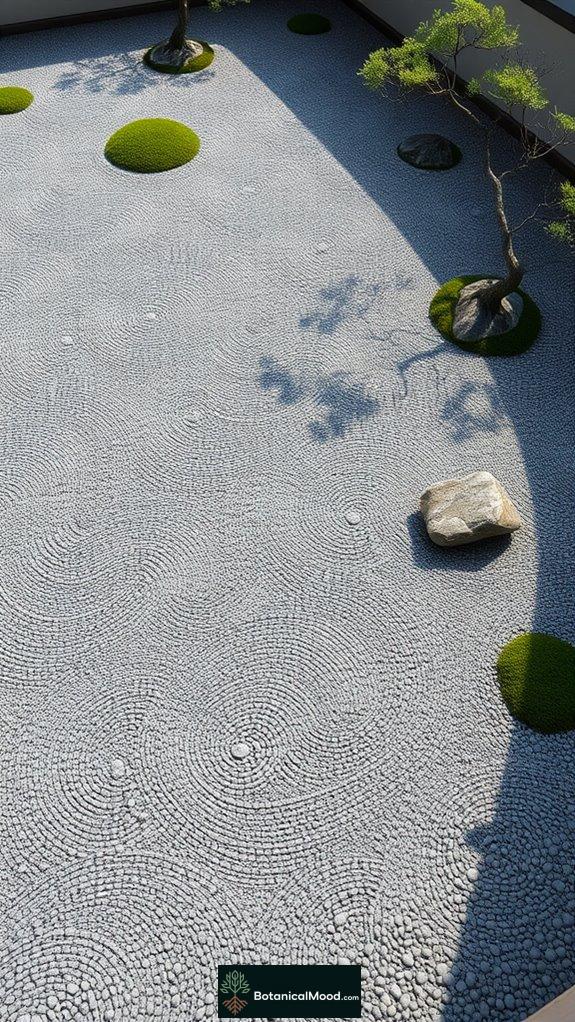
When you step into a Japanese Zen garden, it feels as if you've entered a serene domain where simplicity and nature intertwine effortlessly.
These gardens showcase minimalism, allowing rocks and sand to represent life's impermanence. The asymmetry of each element mimics nature, creating a tranquil balance. Natural elements play a crucial role in enhancing the garden's peaceful atmosphere, inviting a deeper connection with the environment. The meticulous placement of elements reflects traditional Japanese landscaping principles that prioritize harmony and balance.
I'm captivated by the way gravel patterns symbolize flowing water, while carefully placed stones evoke timelessness.
This harmonious design reflects Zen Buddhism's principles, inviting contemplation and meditation. As I explore these spaces, I appreciate how they embody the essence of tranquility, inspiring me to share their beauty through Botanical Mood.
The Formal French Garden: Order and Elegance
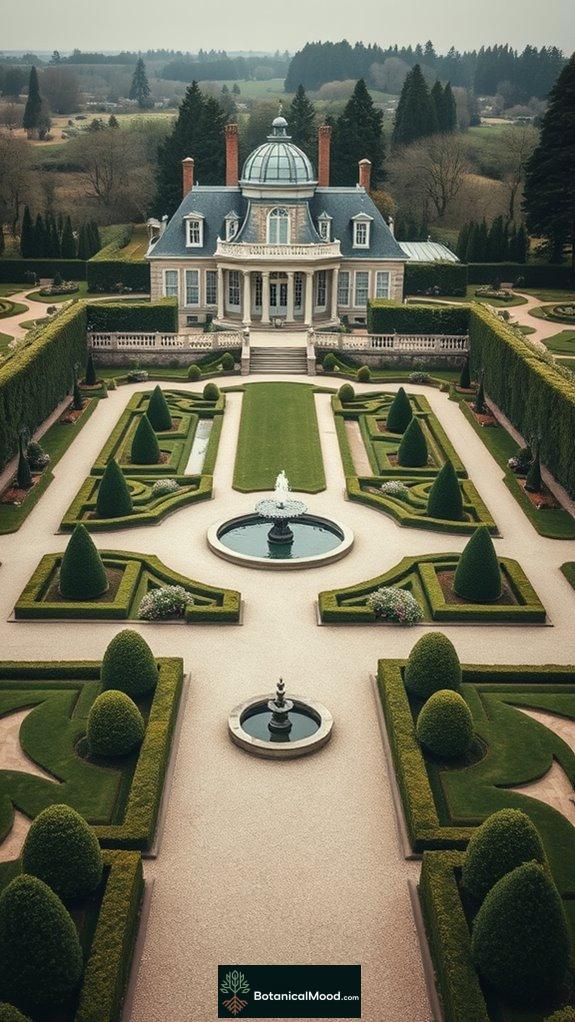
The beauty of a formal French garden captivates with its meticulous order and elegance, standing in stark contrast to the serene simplicity of a Japanese Zen garden.
I find myself enchanted by the symmetry of the paths, leading my gaze directly to the grand residence at its heart. Geometric shapes define the flower beds, while neatly trimmed hedges and topiaries evoke a sense of sophistication.
Water features, like tranquil fountains and reflecting pools, enhance this peaceful ambiance. Each carefully selected plant, from lavender to boxwoods, whispers the rich history of French design, reminding me why I created Botanical Mood—to celebrate such exquisite beauty and cultural significance. The principles of symmetrical formal gardens are deeply rooted in the French landscape tradition, showcasing a perfect blend of artistry and nature.
The English Cottage Garden: A Celebration of Biodiversity
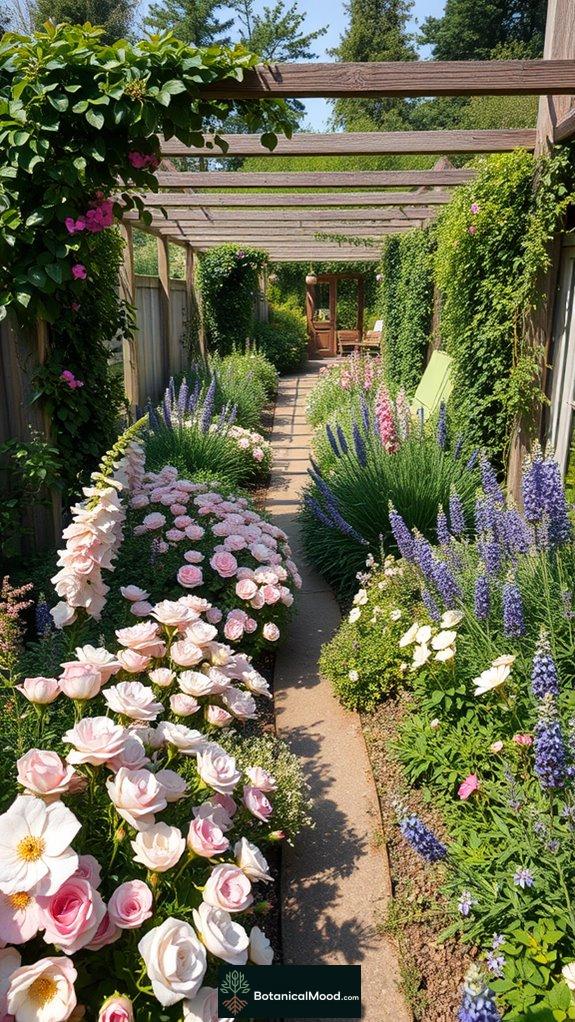
Cottage gardens, with their charmingly chaotic design, draw me in with their vibrant displays of life and color. These enchanting spaces celebrate biodiversity, featuring an array of plants that create a lush tapestry. I can't help but admire how they evolved from practical beginnings into decorative havens that embody sustainability. This pastel wildflower garden aesthetic highlights the beauty of diverse plantings that foster ecological balance.
| Plant Type | Examples | Benefits |
|---|---|---|
| Flowers | Roses, Foxgloves, Irises | Attract pollinators |
| Herbs | Lavender, Rosemary | Culinary and medicinal uses |
| Climbing Plants | Honeysuckle, Climbing Roses | Vertical interest and beauty |
Cottage gardens truly reflect a love for nature, inspiring my passion for botanical design.
The Persian Garden: Symbolism of Paradise
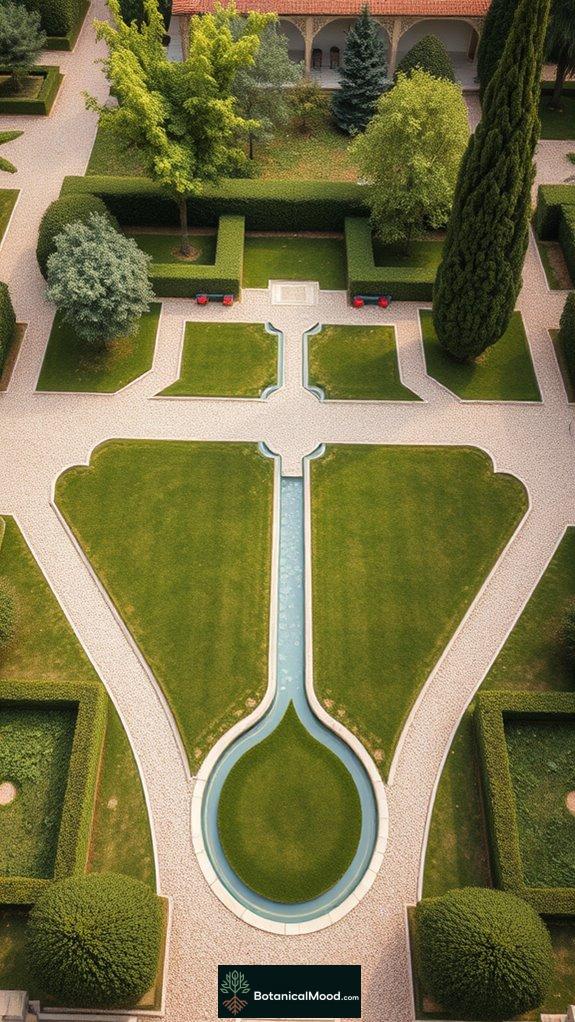
While exploring the elaborate world of garden design, I find that Persian gardens stand out as extraordinary representations of beauty and spirituality.
These gardens, rooted in ancient traditions, symbolize paradise or "Pardis," inviting us into a harmonious universe.
The iconic Chahar Bagh layout divides the garden into four sections, echoing cosmic balance, while flowing water features reflect purity and abundance.
Evergreens like cypress symbolize immortality, adding depth to this serene space.
At Botanical Mood, I celebrate these enchanting designs that connect us to cultural heritage, reminding us of nature's profound beauty and the artistry involved in creating such peaceful retreats.
The Italian Renaissance Garden: Harmony and Perspective
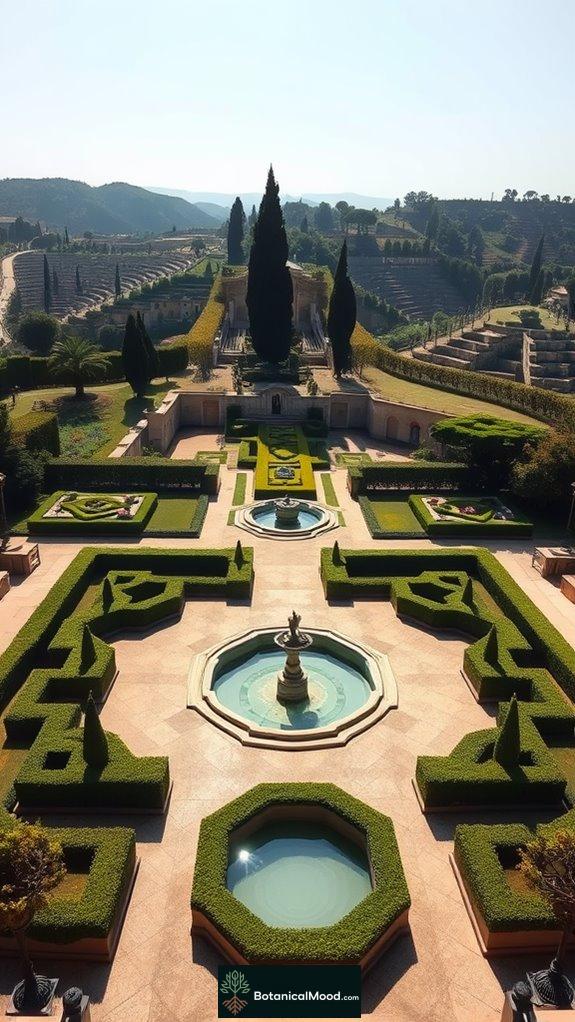
Amidst the flourishing artistry of the Italian Renaissance, gardens emerged as remarkable expressions of harmony and viewpoint, enchanting anyone who steps into their meticulously designed spaces. These gardens blended natural beauty with architectural elements, creating a dialogue between nature and art. One key aspect of these designs was symmetrical formal gardens, which emphasized balance and proportion in their layout.
| Design Element | Description | Purpose |
|---|---|---|
| Geometric Patterns | Squares and circles | Emphasize order and symmetry |
| Water Features | Fountains and pools | Aesthetic and practical appeal |
| Terracing | Hillside terraces | Offer panoramic views |
| Grottos | Hidden spaces | Add surprise and mystery |
| Axial Symmetry | Mirrored layouts | Create visual harmony |
Such elegance inspires the essence of my website, Botanical Mood, celebrating these timeless designs.
The Chinese Scholar's Garden: A Balance of Art and Nature
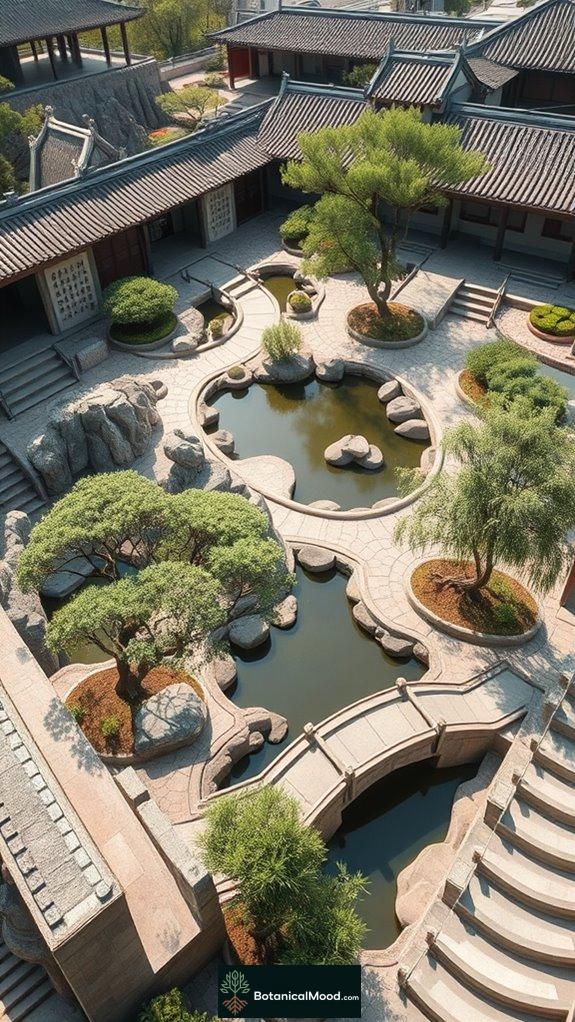
The Chinese Scholar's Garden stands as a tribute to the profound connection between art and nature, offering a serene sanctuary where beauty and contemplation intertwine.
Here, rocks symbolize eternal mountains, while water reflects the ever-changing flow of life. I'm captivated by the thoughtful arrangement of plants and architecture, each element chosen for its aesthetic and cultural significance.
The harmony of yin and yang envelops me, inviting reflection through winding paths and moon gates.
Inspired by my love for these gardens, I created Botanical Mood to share their beauty and cultural depth, encouraging others to embrace this artistic balance in their own lives.
The Moorish Garden: Intricate Designs and Water Features
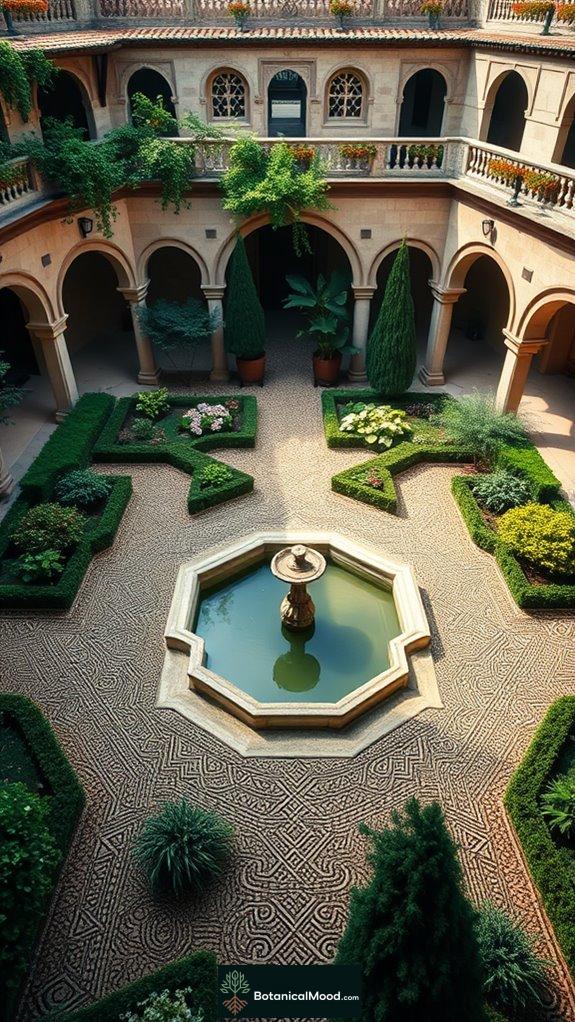
What makes the Moorish garden so enchanting is its complex interplay of design and function, where every element serves a purpose while contributing to a harmonious aesthetic. The geometric patterns, lush greenery, and soothing water features invite a sense of tranquility. Additionally, the Moorish garden is deeply influenced by medieval European landscape architecture that emphasizes symmetry and order in its layouts.
| Element | Description |
|---|---|
| Water Features | Fountains and reflective pools create cooling effects. |
| Architectural Features | Arches and courtyards frame views and provide shade. |
| Plant Selection | Evergreen hedges and fragrant herbs create structure and allure. |
As I explore these gardens, I'm reminded of their rich history and the inspiration they provide for my own gardening journey at Botanical Mood.
The Native American Medicinal Garden: Cultural Significance and Sustainability

Gardens inspired by Native American medicinal traditions showcase a profound connection between culture and nature, where every plant tells a story and serves a purpose.
These gardens honor the rich heritage of indigenous knowledge, reminding us of the plants that heal and sustain.
With intentional designs reflecting balance and unity, they create spiritual spaces for community healing.
Each plant is chosen for its medicinal significance, providing a holistic approach to health.
By embracing these sustainable practices, we support biodiversity and ecological balance.
At Botanical Mood, I celebrate these gardens, hoping to inspire others to appreciate the deep cultural roots within our environments.
The Colonial American Garden: Blending Old World and New World
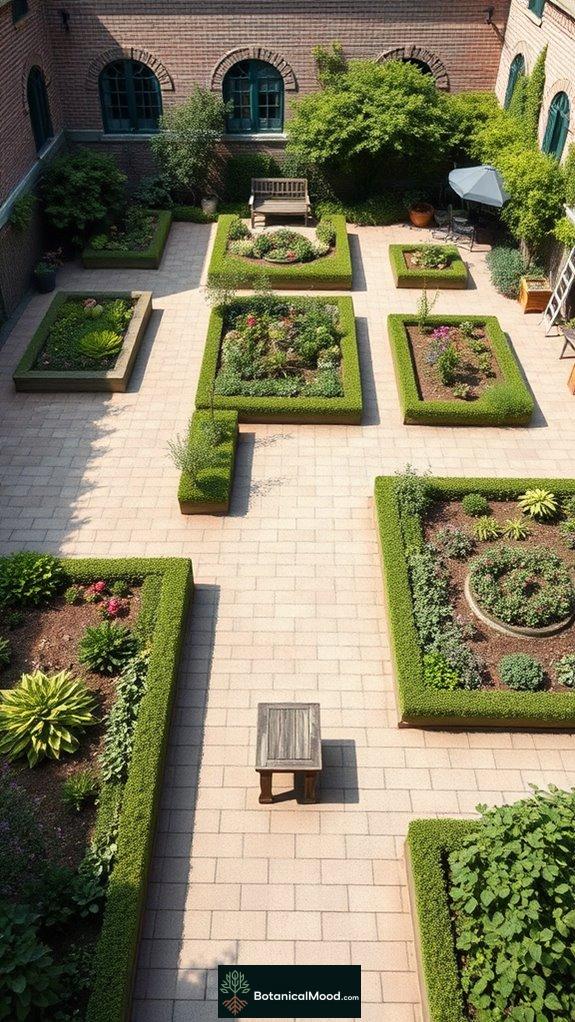
Colonial American gardens reflect a fascinating blend of the Old World's elegance and the New World's raw beauty, creating spaces that are both functional and visually stunning.
As I wander through these gardens, I see structured layouts with straight walkways and geometric beds, showcasing a mix of fruits, herbs, and flowers. Raised beds, framed by hedges, invite exploration.
Focal points, like charming seating areas, encourage lingering.
Every plant tells a story—roses for beauty, herbs for healing. These gardens not only provided sustenance but also a glimpse into the colonists' lives.
I created Botanical Mood to celebrate such rich histories and inspire your own garden journey.
The Mediterranean Garden: Adaptation to Climate and Culture
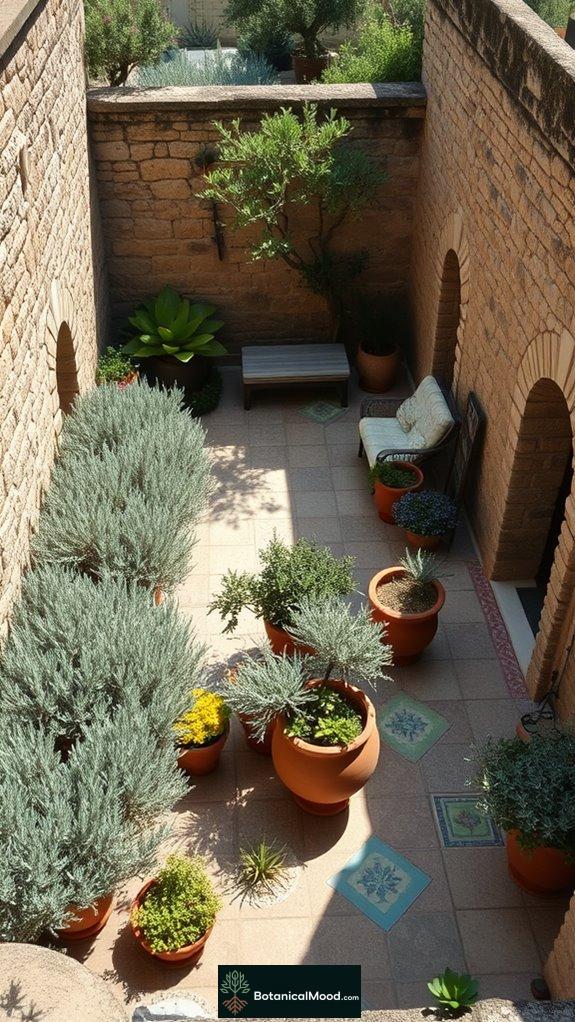
While exploring the enchanting world of Mediterranean gardens, I find myself captivated by their unique ability to adapt to both climate and culture.
These gardens beautifully blend history with practicality, showcasing elements that create a serene atmosphere.
- High walls offer intimacy and protection.
- Drought-resistant plants thrive under the sun.
- Colorful tiles and stone structures reflect local artistry.
- Edible plants like herbs and olives enhance the experience.
This adaptability not only preserves cultural heritage but also inspires me, as I created Botanical Mood to celebrate such remarkable garden designs. Additionally, the use of drought-resistant plants ensures sustainability in the face of climate challenges.
The Mediterranean truly invites us to savor nature's beauty.
Cultural Landscape Pattern Design
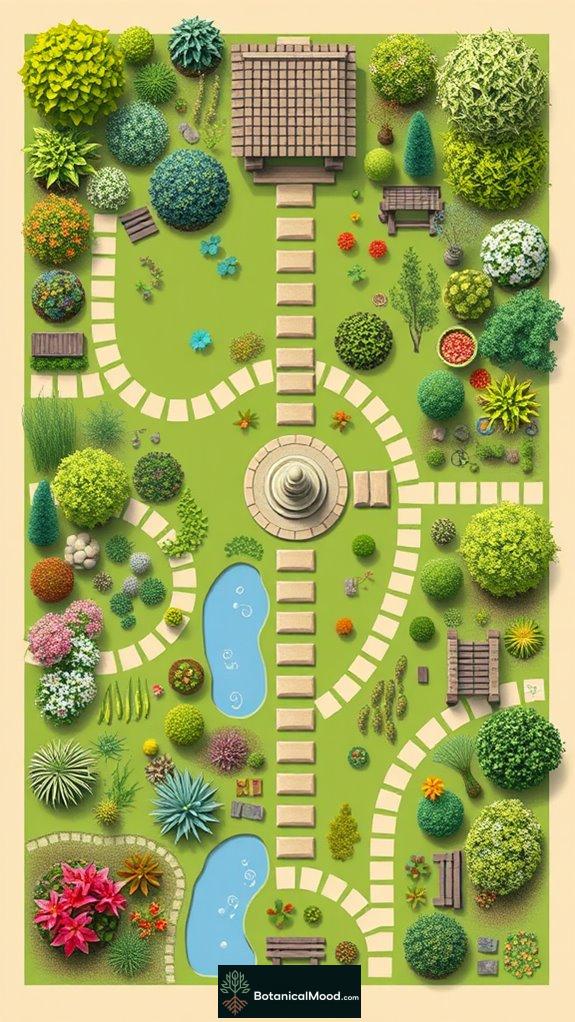
Cultural terrain pattern design captivates me, as it intertwines artistry and functionality in ways that resonate deeply with our connection to the environment. When I explore various environments, I notice how clearly defined gardens, like the Taj Mahal, showcase human creativity, while organically evolved spaces reveal a long history of adaptation between people and nature. Associative cultural environments, such as Uluru, speak to our spiritual ties to the land, reminding me that every garden tells a story. These landscapes often reflect cross-cultural patterns that highlight the diverse ways cultures engage with nature over time. At Botanical Mood, I aim to inspire you to appreciate these elaborate designs and their rich histories while creating your own personal sanctuary.
Cultural Symbolism in Garden Design
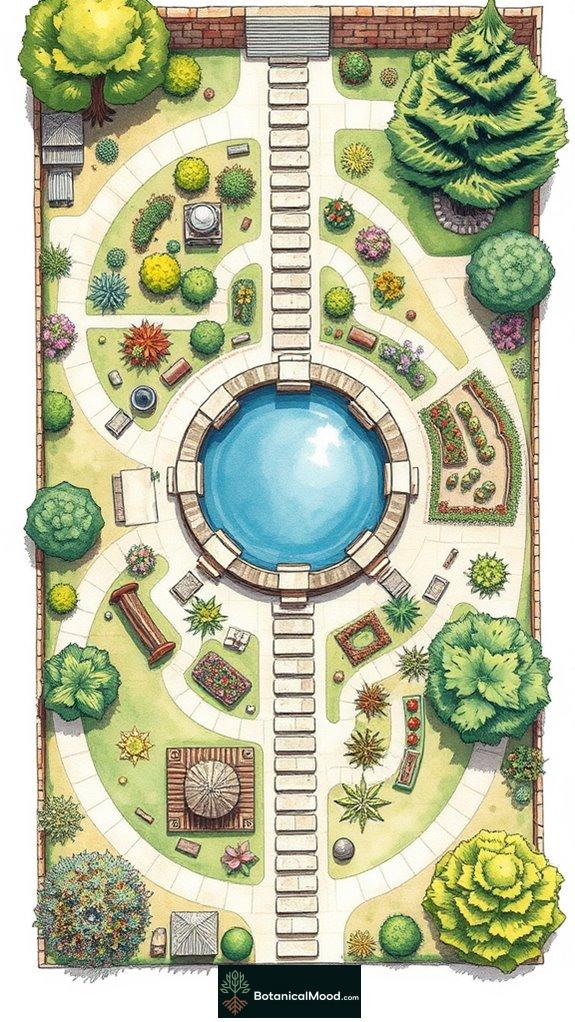
As I explore the world of garden design, I find that each element often carries profound cultural symbolism, enriching our experience with nature.
Here are a few fascinating examples:
- Water Features: They symbolize spiritual renewal, found in Persian and Chinese gardens.
- Tree Usage: Pine trees represent longevity and steadfastness, especially in Chinese culture.
- Rock Formations: In Chinese gardens, rocks embody eternity and connection to the earth.
- Geometric Patterns: The chahar-bagh design in Persian gardens reflects the cosmic order.
At Botanical Mood, I aim to share these beautiful principles, inspiring others to create meaningful spaces.
Historical Garden Layout Styles
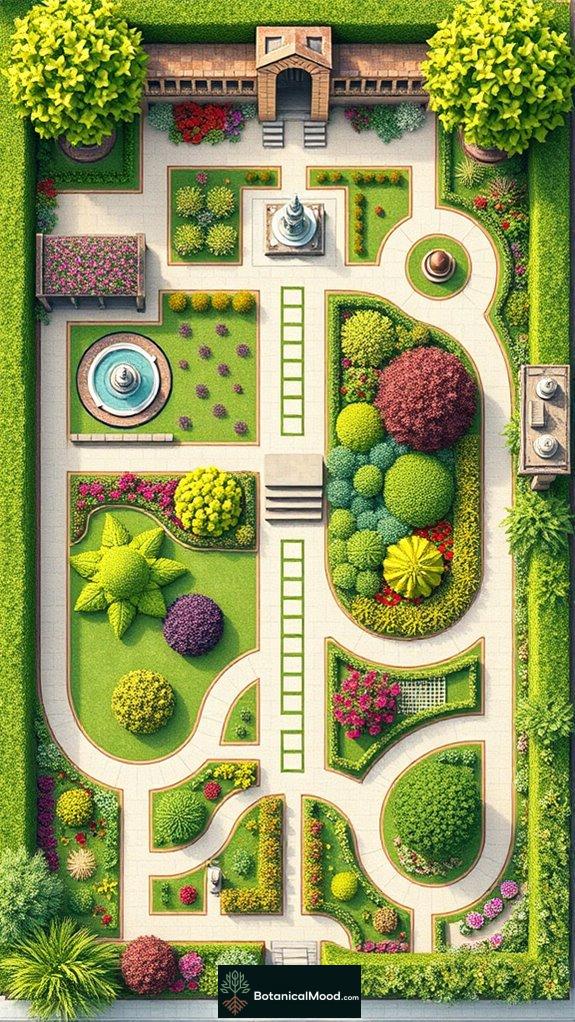
Throughout history, garden layouts have evolved considerably, reflecting the cultural and artistic movements of their times.
I find it fascinating how Roman courtyard gardens, with their fountains and statues, influenced the Mediterranean style. In Britain, we adapted these concepts for our climate, creating productive orchards and vineyards.
The elegance of Dutch and French designs also shaped our terrains, introducing formal patterns and classical motifs.
From medieval enclosed spaces to Georgian grottos, each era brought distinctive elements, like knot gardens and topiary.
I created Botanical Mood to celebrate these historical styles, drawing inspiration from their beauty while embracing contemporary gardening practices.
Creating Functional Garden Spaces
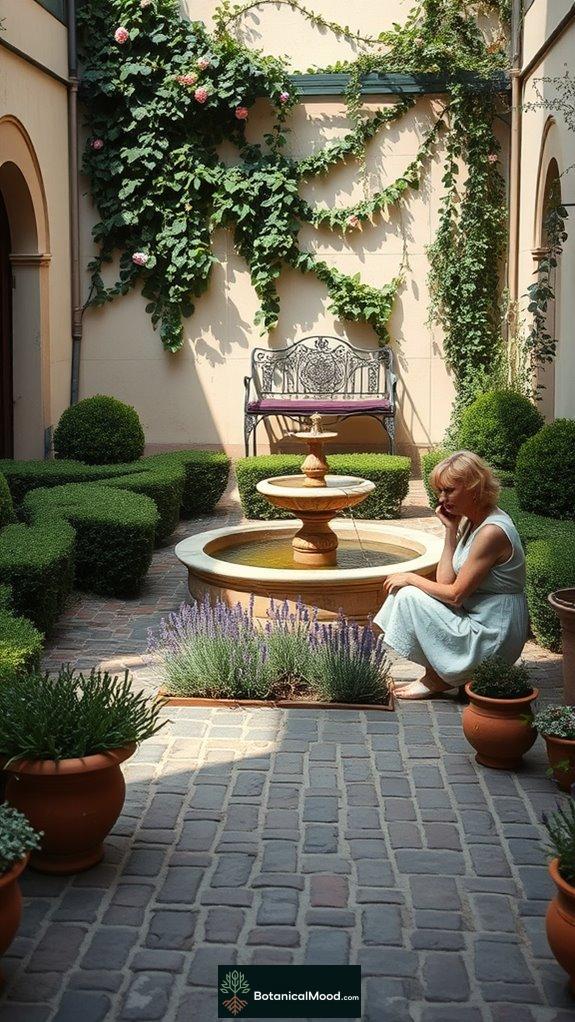
Creating functional garden spaces involves more than just planting a few flowers or setting up a patio; it's about designing areas that cater to specific activities while enhancing the overall user experience.
Here are a few key principles to reflect upon:
- Understanding User Needs: Tailor your garden for those who'll enjoy it.
- Activity Zoning: Create designated areas for dining, relaxation, or play.
- Sustainable Design: Integrate eco-friendly practices like rainwater harvesting.
- Multifunctional Elements: Use design features that serve various purposes, maximizing utility.
As I curate content for Botanical Mood, I aim to inspire you to create spaces that resonate with your lifestyle and values.
References
- https://www.piatraonline.com/the-7-principles-of-zen-applied-to-japanese-garden
- https://www.epicgardening.com/japanese-zen-garden/
- https://www.housebeautiful.com/lifestyle/gardening/a46354891/zen-gardens-japanese-culture-guide/
- https://www.travelcontentcreators.com/japanese-zen-garden/
- https://danslegris.com/blogs/journal/japanese-zen-garden
- https://www.french-gardens.com/design/frenchgardendesign.php
- https://www.shrubhub.com/blog/french-garden-landscape-design-where-history-culture-nature-flourish.php
- https://theoxfordshiregardener.co.uk/jardin-a-la-francaise/
- https://www.chezpluie.com/blogs/news/8-ways-to-create-your-french-garden
- https://www.thespruce.com/what-is-a-french-garden-5069891

Leave a Reply